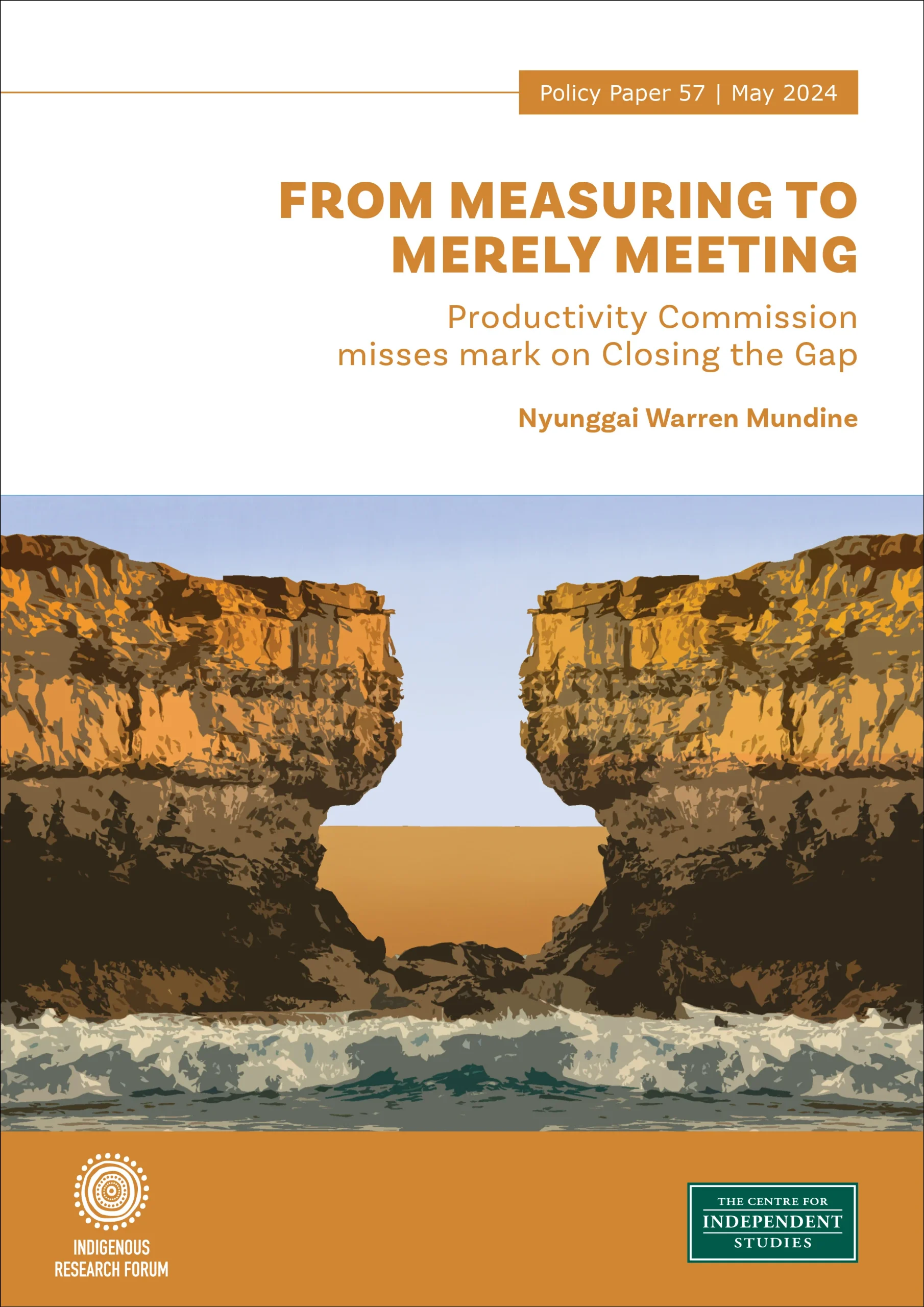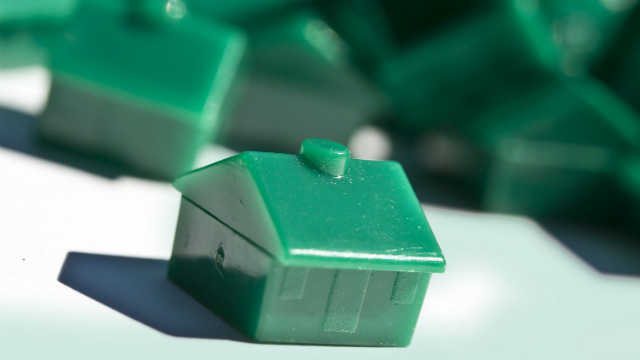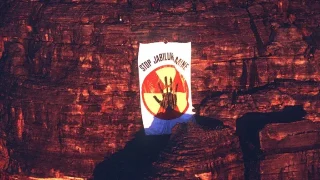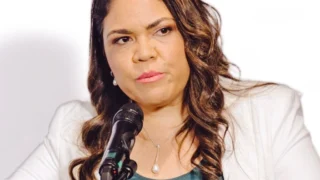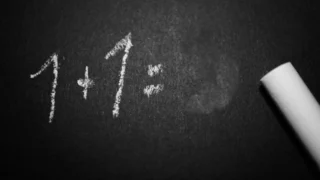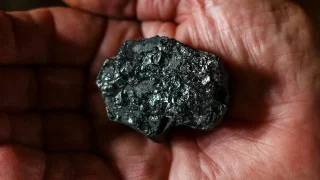
Introduction
Why, despite decades of expenditure on Aboriginal affairs, do solutions to ‘Closing the Gap’ in life outcomes for Indigenous and non-Indigenous people remain elusive?[1] Part of that expenditure has been Closing the Gap Agreements, which commenced in 2008 under the Rudd government, with little apparent success.
Prime ministers have presented parliament with a Closing the Gap report every subsequent year. In 2019, perhaps weary of having had to report that only two of the seven Closing the Gap targets were on track, then Prime Minister Scott Morrison pivoted to the next iteration in a long line of attempts to frame Indigenous policy. Inferring from his predecessor’s efforts that the government “did not truly seek to partner with Aboriginal and Torres Strait Islander peoples”, Morrison pronounced: “Today, I’m calling that out.”[2]
In 2020, the Coalition of Aboriginal and Torres Strait Islander Peak Organisations and all Australian governments signed a National Agreement on Closing the Gap. The agreement’s objective was to overcome the “entrenched inequality faced by too many Aboriginal and Torres Strait Islander people.”[3]
In 2022, then federal Treasurer Josh Frydenberg sent a reference to the Productivity Commission asking it to review progress on Closing the Gap. Aboriginal voices were deeply involved with all Australian governments and the commission’s Closing the Gap Agreement review. The treasurer’s reference reflected Morrison’s proposition that ‘true partnership’ was the solution to closing the gap.
The treasurer directed the Productivity Commission to:
- Analyse progress on Closing the Gap against the four priority reform outcome areas:
- Formal partnerships and shared decision-making;
- Building the community-controlled sector;
- Transforming government organisations;
- Shared access to data and information at a regional level.
- Analyse progress against all socio-economic outcome areas; and
- Examine the factors affecting progress.
By the time the 2022 reference hit the commission, it had already dramatically shifted ground: from analyst to enthusiast. For example, in 2017, Peter Harris — then Chair of the Productivity Commission and Chair of the Steering Committee for the Review of Government Service Provision — emphasised the importance of “robust, public evaluations to understand the adequacy, effectiveness and efficiency of government spending” on Indigenous people[4] but that it was outside the scope of his report.[5]
In 2020, the commission published two reports: Overcoming Indigenous Disadvantage[6] and the Indigenous Evaluation Strategy.[7] In the latter, the commission created a methodology for evaluating Indigenous programs; a belated recognition that “evidence about what works and why remains thin.”[8] Unfortunately, the evaluation strategy was concerned more with who owned and controlled the analysis than the analysis itself.[9]
In a 2023 speech on productivity and closing the gap, Productivity Commission Chair Michael Brennan said: “We have had to build our cultural capability, we have hired new Aboriginal and Torres Strait Islander staff.” He did not disclose a single evaluation of an Indigenous program.
From measuring to meetings
The Productivity Commission has shifted from evaluation towards ‘shared decision-making’ to close the gap — from measuring to meeting.[10] This shift is reflected in the Commonwealth allocating money to ‘policy partnerships’. Beginning in 2021, almost $50 million has been allocated over three years for co-chaired partnerships between government departments and Indigenous organisations such as National ATSI Legal Services, National Voice of Children (SNAICC), Gayaa Dhuwi on mental health, National ATSI Housing Association and First Languages Australia.
Partnerships are not assessments of government expenditures’ adequacy, effectiveness, and efficiency. On that front, the federal government has established The Closing the Gap Outcomes and Evidence Fund, which provides up to $38.6 million in funding from 2021 until December 2026. There are only two target projects: the over-representation of Indigenous children in out-of-home care and family violence and abuse against Indigenous women and children.[11]
As of March 2024, the Department of Social Services responsible for the projects, is “working with local First Nations stakeholders to plan and implement project co-design, delivery and evaluation in priority locations” — i.e. more meetings. At this stage, projects are still “under development.”[12] Another entity, The National Indigenous Australians Agency (NIAA) — previously under Prime Minister and Cabinet — responsible for funding federal government programs, has had an evaluation program since 2018.[13] Numerous programs have been subject to evaluation.[14] The Indigenous evaluation committee of NIAA has proudly stated: “A clear theme of discussions was the importance of centring the voices of Aboriginal and Torres Strait Islander communities in data, evidence and insights.”[15] A possible result of such ‘centring’ was seen in one of the evaluations of a significant report by RAND, a study for the federal government of Violence against Women (discussed below), which was incomplete because of tardy cooperation from the Australian Institute of Aboriginal and Torres Strait Islander Studies.[16]
Another limitation of NIAA evaluations is the limited nature of policy options. For example, the 2018 evaluation of the Community Development Program (CDP) for remote area employment concluded that the introduction of the CDP “increased the probability of a participant achieving at least one job placement by 1.3 percentage points as opposed to a result under the forerunner program Remote Jobs and Communities Program”[17] — that is, there had been no improvement.
CDP was the relabelled RJCP, which was the relabelled Community Development Employment Projects Program (CDEP), and these have collectively been evaluated more than 30 times. Disturbingly, the 2018 CDP evaluation recommended ‘giving providers some flexibility to negotiate how employment outcomes are defined.’[18] In other words, when the results are not good, the measures should be fixed to suit them. Contrast this study with earlier evaluations of CDEP.
In 1997: “…lack of tangible and convincing evidence of success, be it in income supplementation, employment creation, community development or enterprise creation.” In 2009: “The communities in which CDEP operates are economies substantially characterised by the recirculation of public income and the consumption of public goods and services. In few instances, is value created sufficient to justify the income and goods and services consumed.”[19]
Such a mindset is reflected in the commission’s ideological position that inequality must never be attributed to Indigenous people or their location outside the economy but rather to “current and historical inequities”,[20] which constrain the options and recommendations to help people escape inequality. The propensity to meet rather than measure or to change the measure of success when the outcomes do not suit political objectives may help to explain the nature of the federal government’s reference to the Productivity Commission and its response. Significant issues are inherent in this shift, which is the subject of this paper.
What the commission did
The Treasurer’s directions to the Productivity Commission did not have the necessary precision. Progress in direction one, the four priority reform areas, concerned decision-making architecture such as formal partnerships between governments, community-controlled organisations and data sharing. The commission was asked to report progress on ‘meetings’, not evaluation.
Decision-making architecture may have little to do with closing the gap in the living conditions of Indigenous Australians, which is the subject of directions two and three. The latter terms of reference — to analyse progress against socio-economic outcomes and factors affecting progress — were wide enough to have the commission analyse what was going wrong in the lives of those Indigenous people suffering entrenched inequality — that is, an evaluation of programs designed to close the gap.
Consistent with the desire to build its cultural capability, two commissioners for the 2022 inquiry were appointed who acted as champions for the politics of shared decision-making and recommended much more radical decision-making architecture. The message these commissioners sent to the government was “the lack of power sharing needed for joint decision-making, and the failure of governments to acknowledge and act on the reality that Aboriginal and Torres Strait Islander people know what is best for their communities.”[21]
The commissioners made four recommendations to give effect to this radical thesis:
- Amend Priority Reform 1 to recognise self-determination under the United Nations Declaration on the Rights of Indigenous Peoples (Priority Reform 1);
- Set up an independent mechanism to examine progress on all Agreement aspects. A potential feature of the mechanism is that it does not engage in program delivery or administer funding or programs so that it is never in a position of needing to pass judgment on its own actions or inaction (related to Priority Reform 2);
- Government departments overthrow historic and current institutional racism, unconscious bias and engagement practices by truth-telling to enable reconciliation and active, ongoing healing (Priority Reform 3); and
- Recognise ‘Indigenous Data Sovereignty’ by establishing a Bureau of Indigenous Data (Priority Reform 4).
The commission argued that the national agreement “builds on a long history of Aboriginal and Torres Strait Islander peoples’ ongoing sovereignty and self-determination.”[22]
This statement is not grounded in the law or fact. The commission appeared to want to re-establish the Aboriginal and Torres Strait Islander Commission — a body abolished with the agreement of both major political parties, neither of which has sought its reinstatement.[23] The commission accepted some profoundly challenging claims by Aboriginal organisations that Aborigines have ‘knowledges’ and that ‘Aboriginal data sovereignty’ must be acceded to. These are very recent and radical means to control research outcomes. They represent serious challenges to social science and rational policy-making.
The commission compounded the fault by accepting the following proposition, repeated ad nauseam by many Aboriginal community-controlled organisations (ACCOs) throughout the report and the accompanying background paper:
Self-determination provides the best means to better outcomes. Aboriginal Peak Organisations Northern Territory[24]
Self-determination was mentioned 49 times in the 99-page report and 153 times in the 430-page accompanying paper. Amid demands for self-determination, there were calls to fund it. It could be argued that it is not self-determination if the taxpayer has to fund it. For example, at a local scale, Doomadgee, an Aboriginal community in far north Queensland, wanted money to discuss the programs in their community.[25] There are 18 families in Doomadgee. They could readily organise their voices.[26]
There are many reasons why some groups do not fare as well as others. For example, they may not share the same values or ambitions as the dominant group. It is difficult to see how ‘power sharing’ resolves those issues.[27]
Not satisfied with the agreement that shared decision-making was the answer to closing the gap, the commission recommended a form of sovereignty for Indigenous people under the UN Declaration. The commission sought a more radical position than the agreement. Not satisfied with the agreement that there should be shared access to data, they recommended Indigenous data sovereignty — which was not defined but simply accepted as a new idea that had entered the areas courtesy of submissions from Aboriginal organisations. The commission recommended establishing a Bureau of Indigenous Data which, in effect, would hand Aboriginal-controlled organisations power over outcomes but carry no responsibility for the consequences.
What the commission should have done
The governments responsible for the Closing the Gap Agreement are at fault for allowing a drift into an ideological position that power-sharing is a substitute for evaluating what works to close the gap. For example, the agreement states that too many Indigenous people “face entrenched inequality” — implying that not all suffer entrenched inequality.
Within the bounds of the Treasurer’s directions, the commission could have asked whether Aborigines succeeded because of Aboriginal organisations or, like other Australians, whether they succeeded with the assistance of services run by competent people. ACCOs dominated submissions and attendance at public hearings. The evidence accepted by the commission did not prove that ACCOs were the solution.
The commission could have asked what outcome measures should be demanded of services to Indigenous clients and what evidence should be required to prove that a program caused the outcome. The Office of Impact Analysis, Prime Minister and Cabinet, sets out the proper methodology for impact evaluation.[28] The Australian Treasury has also established The Australian Centre for Evaluation[29] which seeks to improve the evaluation evidence to support better policies and programs. The commission could have invoked this work under the terms of reference, directions two and three.
To disentangle the drift to the ideology of power-sharing inherent in the commission recommendations, the commission should have invoked its expertise in evaluation and using directions two and three to ask (among many others) three questions:
- Which Aborigines suffer entrenched inequality?
- Do Aboriginal ACCOs have a better track record in delivering services?
- How does ‘data sovereignty’ affect the validity of research and programs?
Which Aboriginal people suffer entrenched inequality?
The commission, while advising governments about entrenched inequality, should have reported that income inequality is more pronounced for Indigenous people than for the rest of Australia. Indigenous incomes are increasing faster than for the rest of the population. Indigenous poverty in urban areas has dropped substantially and should reach parity in 20 years and incomes among the top 10 per cent of Indigenous earners have increased significantly. However, the poverty rates for Indigenous people in remote areas have increased.[30]
There are various ways to distinguish different Indigenous people that would have been important to a report on closing the gap. About 80 per cent of Indigenous people are doing about as well as other Australians.[31] Some are poor, like other Australians, but many are doing well. The evidence that there are at least two classes of Indigenous people is abundant.
A dominant group lives about as well as other Australians and makes good use of all Australia offers in terms of income, education, employment and health. There is a sub-group that suffers blighted lives. An illustration of this is a recent seminal study that concluded that 80 per cent of Indigenous men who have never been in gaol are doing about as well as other Australian men. The other 20 per cent, those who have been in gaol, are in big trouble. The study’s authors refer to the 80/20 split as an ‘incarceration gap’, a play on the federal government’s closing the gap policy.
Using this measure, the differences between the two classes of Indigenous people are stark. The Year 10 completion rate was only 50 per cent for Indigenous males who have been in gaol, which was substantially lower than the Year 10 completion rate of those who have never been in gaol, which was 73 per cent, compared to 88 per cent for all Australian males.
Indigenous males who have never been in gaol were employed at roughly the same rate as the general Australian male population, 56 per cent compared to 65 per cent. Only 25 per cent of the gaoled group reported being employed. More than half of the gaoled group were not in the labour force. Another significant gap was substance abuse. Almost 30 per cent of gaoled Indigenous people reported problems (comparable to non-Indigenous prisoners), compared to just 7 per cent of never-gaoled Indigenous people.
The way people conduct themselves also affects their well-being. For example, since 2008 Aboriginal and Torres Strait Islander researchers have conducted face-to-face surveys with the primary carers of 1677 Indigenous children selected from 11 sites across Australia.[32]
The scholars were at pains to reinforce the importance of children ‘knowing their culture’ and that their identity would be necessary for ‘growing up strong’. Part of this story of identification and children growing up strong were measures of carer self-identification and cultural adherence. These were compared by location of carer using levels of isolation — from remote communities to city locations.
Self-identification was argued to be an essential element of cultural expression. For example, 90 per cent of Indigenous people in remote communities identified with a ‘mob’. This reduced to 50 per cent for those in cities. Most Indigenous carers in remote communities view their identity as the most important thing. In contrast, those in the city would likely list their identity as ‘important but not the only thing’.
Carers were asked to rate their community on several ‘neighbourhood problems’ according to three measures: ‘happens all/a lot of the time’, ‘happens a bit of the time’, and ‘doesn’t happen here’. The ‘happens all/a lot of the time’ results are presented for simplicity. Neighbourhood problems of ‘dangerous driving/hooning/burnouts’ and ‘break-ins/robbery/ theft’ did not exhibit any differences across communities and ‘racially-motivated violence’ ranged from 6 per cent in cities to 2 per cent in remotes. The latter results suggest little racism and little ‘extra’ racism for those Aboriginal people who live among non-Indigenous people.
However, the differences between the city and remotes were stark for the seven criteria in Table 1. The incidence of family violence ‘happening all/a lot of the time’ in remote communities was 30 per cent, four times higher than in cities. On each other measure of dysfunction, life in remote communities was more than twice as bad as in city-based Indigenous communities.
One element of the table especially needs to be understood. People being pressured to support others, also known as ‘demand sharing’ or ‘humbugging’, is a significant part of Indigenous culture. In remote communities, 27 per cent of respondents answered that this happened all/a lot of the time. In city communities, only 5 per cent of respondents answered that it happened all/a lot of the time.
| Neighbourhood problem | Not remote
% ‘Happens all/a lot of the time’ |
High remote
% ‘Happens all/a lot of the time’ |
| Drinking too much grog | 15 | 55 |
| Drug taking | 19 | 42 |
| Family violence | 7 | 30 |
| Young people fighting | 12 | 27 |
| People pressured to support others | 5 | 27 |
| Children being out at night | 19 | 41 (51 moderate remote) |
| Children not going to school | 16 | 34 |
Table 1: Neighbourhood Problems by Remoteness. Source: Walter, M. ‘Doing Indigenous Family.’ In Walter, M., Martin, K., & Bodkin-Andrews, G. (Eds.). (2017). Indigenous Children Growing Up Strong: A Longitudinal Study of Aboriginal and Torres Strait Islander Families. Palgrave Macmillan, 133
Indigenous people who exhibit absolute cultural mores in remote communities are not doing as well as those who live elsewhere and do not exhibit such mores. So, where is the distinguishing public policy response to these facts? Why is there strength in identity and Indigenous sovereignty when those with the least ‘identity’ attributes have the fewest problems and those with the most have the most problems?
The difference is as between Melbourne and Yuendumu Indigenous people. Only when the reasons are understood or admitted as to why 80 per cent succeed and 20 per cent fail will there be an escape for the 20 per cent. The commission must have been aware that — to use Thomas Sowell’s term — disparities may not result from discrimination.[33]
Do Indigenous ACCOs have a better track record in delivering services?
As well as failing to differentiate between Indigenous peoples and communities, the commission accepted submissions that Indigenous community-controlled services were superior performers. The commission suggested: “There is growing evidence that ACCOs can improve outcomes for Aboriginal and Torres Strait Islander people.”[34] However, it is unclear what evidence the commission relied on. Thus there is no indication of whether the evidence was robust and — where it was positive — whether it could apply to all ACCOs across all services and Indigenous communities. Nor has there been any exploration of the consequences of other providers withdrawing service in favour of ACCOs.
The commission said: “The evidence base is particularly prominent in health services, where health ACCOs not only have an essential role in addressing immediate healthcare needs but also … in the more entrenched structural determinants of health.”[35] The commissioners supported a submission by the National Aboriginal Community Controlled Health Organisation (NACCHO) which placed great weight on a 2012 study that found while services delivered by Indigenous community-controlled health organisations increased, the intervention costs, utilisation and treatment adherence rates also increased.[36] However, the study provided a mechanism by which intervention data obtained from mainstream sources could be adapted to allow its economic evaluation as if delivered from an Indigenous community-controlled service.[37] This in itself is not definitive proof of superior service outcomes.
The study relied on highly qualified estimates such as the enhanced rate at which Aboriginal people use Aboriginal-controlled services.
“It is impossible to know … how much of this difference is a reflection of under-identification of Indigenous people … or to what extent it represents lower use of GP services by Indigenous Australians.’’[38]
In other words, no weight should be placed on the claim of greater utilisation rates by Indigenous-controlled health services.
The study also quoted two sources for estimates of adherence: the enhanced rate at which Indigenous people continue their medication and other health regimes when they use Indigenous-owned services.
The first study estimated childhood immunisation rates.[39] This study did not mention Indigenous community-controlled health services.
The second study estimated immunisation rates for different social classes and groups, including Indigenous ones. It did not refer to ACCO services.[40] This study did not identify the incidence of immunisation in remote areas. Instead, it quoted from another study, a North Queensland survey of Aboriginal children and their vaccinations which concluded that the “vaccination status of Indigenous children who reside in remote communities is substantially better than that of Indigenous children from either rural towns or urban setting.”[41]
The North Queensland study could not explain the better result for the remote setting. By contrast, a later study using the Australian Childhood Immunisation Register concluded a “clear trend in coverage for Indigenous children by remoteness was not evident.”[42]
Another example the commission raised was a study of the ‘health equity’ ambitions of ACCOs,[43] which they assert “provide culturally-informed, holistic health services that directly and indirectly address the social determinants of health.” The study consisted of a textual analysis of recent annual reports of 67 ACCOs.
The social determinants of health methodology are based on the observation that the poor get sicker than the rich and that therein lies a solution to ill health. This observation does not provide a solution to how the poor are to become rich, nor does it address health as a medical issue. In the Indigenous context, it drifts into the belief that only Indigenous organisations can help.
The Indigenous-led team looked for evidence among the annual reports that activity aimed to influence “societal values towards greater inclusion of Aboriginal people.” An example of this was an ACCO that hosted “cultural immersions for key external service partners and members of government.”
Another was “a working partnership with students and staff from [a local private school] in painting a mural.” Another, while ‘addressing clinical care’, “held a men’s painting group … addressing cultural, spiritual and social wellbeing.”
The study concluded that social capital and social cohesion were enhanced such as when “regular community meetings and events were introduced so that all members and the broader community can meet with Board and management representatives.” Actual health outcomes were not reported.
The team sought evidence of the benefits of investing in health ACCOs and, in doing so, revealed the skills gaps in Indigenous community-controlled health services. It showed that while 73 per cent of CEOs and 68 per cent of administration and clerical employees were Indigenous, only 30 per cent were skilled non-health, 8 per cent were general practitioners — none were medical specialists — 15 per cent were nurses and 9 per cent were midwives. Unsurprisingly, 98 per cent of ‘Indigenous health workers’ were Indigenous. The report recommended more money be spent on ACCOs.
While failing to note the lack of Indigenous health staff in ACCOs, the commission should have made clear that whoever runs an organisation must comply with a raft of non-Indigenous regulations. The commission should have clarified that the scope for a non-Indigenous, community-controlled organisation to do anything different from any other organisation is very limited.
Another consequence of accepting the right of ACCOs to deliver services is that experienced providers vacate the field and weaken the level of provision to Indigenous people. For example, Life Without Barriers — Australia’s largest out-of-home care provider — has announced it will transition service delivery for Indigenous children to community control.[44] Their hope is that “the commitment to transition children to community control will ensure they grow up strong in family, kin, and culture.”[45] It is no consolation to Indigenous people hoping for a better outcome if they receive worse services.
How does ‘data sovereignty’ affect the validity of research and programs?
Indigenous Data Sovereignty — a very recent and radical agenda — is a global movement focused on giving Indigenous peoples the right to “govern the creation, collection, ownership and application of their data.”[46]
A 2018 Indigenous data sovereignty summit held in Canberra “proclaimed that Indigenous Data Sovereignty in Australia was derived from Aboriginal and Torres Strait Islander peoples’ inherent right to govern our peoples, country (including lands, waters and sky) and resources as outlined in the United Nations Declaration on the Rights of Indigenous Peoples, for which Australia has declared its support.”[47]
Even though Priority Area Four in the agreement has the modest goal of “shared access to data and information at a regional level”, the commission recommended establishing an Indigenous Data Agency as a part of an Indigenous Data Strategy. Data sovereignty is cited as a solution to the lack of reliable data on Indigenous peoples and the misuse of their traditional knowledge and cultural heritage. The commission appears to conflate the issues of reliable data with knowledge ownership and control.
The commission further asserted that government adoption of Indigenous data practices would also lead to communities and ACCOs having greater authority to determine the Key Performance Indicators used to evaluate service delivery.
The commission aired criticisms of performance monitoring in the agreement. One example was that the agreement “only included outcomes for individuals (that did not account for structural inequities), which contributed to a deficit-based narrative and omitted important outcome areas (such as culture and justice).”
In its submission, the Lowitja Institute explained: “The oversupply of deficit-based data has created a discourse that sees Aboriginal and Torres Strait Islander peoples presented as a problem, or as wholly responsible for inequities.”
There is no deficit data if the outcomes are good. Another was the failure to recognise cultural diversity. This means going beyond an “Indigenous identifier that frames Indigenous people as an ethnic or racial minority population” to recognising Indigenous people as “rights-bearing peoples with a distinctive status that is recognised internationally.”
Indigenous data sovereignty may enhance self-determination, recognition and cultural diversity — and dispense with the need to measure outcomes scientifically — but does it close the gap? The commission was concerned that the measurement approach did not adequately prioritise culture.[48] This seems to be another attempt to undermine a rigorous focus on the problem in favour of anti-racism and structural racism dialogues favoured by critical theorists.
If ACCOs are to be believed, it is society’s fault that the gap exists because indicators fail to “adequately reflect the centrality of culture to life outcomes.” The results in Table 1 suggest that when traditional aspects of Aboriginal culture are central to Aboriginal life, the results are not good. The idea of Indigenous data sovereignty may come at the cost of failing to identify why some Indigenous people are doing well and others are not.
An example of such claims is the experience of a RAND study for the Commonwealth of Violence against Women.[49] The researchers were so frustrated by the ‘data ownership’, an example of which is ethical clearance by an Indigenous committee. They wrote in the report: “[A] major challenge to our work was the time taken to receive approval from the Australian Institute of Aboriginal and Torres Strait Islander Studies [which] ultimately took 16 months and required five separate submissions to AIATSIS.”[50]
Governments have a tough time managing the desire of some Indigenous leaders to restrict access to data that may produce adverse reflections on their people. This is a major ethical problem for research.
It has less to do with ethical considerations of individuals and permissions and more with their leaders’ sensibilities. For example, research projects in NSW that may reflect adversely on Indigenous populations require ethical approval from the Aboriginal Health & Medical Research Council before data access is granted.[51]
The council was established because the first publication using the NSW Human Services Dataset[52] showed that of the 1000 individuals who required the greatest amount of money to administer to their needs, 78 per cent were Indigenous.[53] The ethics approval process was established in response to political pressure from Aboriginal leaders to refrain from telling ‘deficit stories’. Such a response is heading towards Indigenous data sovereignty.
Meanwhile, governments have made great efforts to incorporate more accurate measures of Indigenous Australia. For example, the Australian Bureau of Statistics contains the Centre of Aboriginal and Torres Strait Islander Statistics which has a leadership role in national statistical activity about Indigenous peoples.
The centre engages with communities on health and social surveys, the five-yearly Census, administrative data and data integration projects. The centre helps provide governments with reliable statistical information on Australia’s Indigenous population that can contribute to closing the gap.
These objectives are laudable but have nothing to do with Indigenous data sovereignty. Instead, they intend to make public data more readily available to a section of the Australian public.
Recommendations for future work on Closing the Gap
The analysis of the Productivity Commission report on the Closing the Gap Agreement shows the commission failed to do its job. It failed to report that only a minority of Indigenous people suffer entrenched inequality.
This distinction is a first step in understanding how to close the gap.
The solution to closing the gap may be found in the life pathways of those Indigenous people and other Australians who do not suffer entrenched inequality. The commission should have investigated ACCOs’ claims that they have a superior record in serving Indigenous clients. It should have reported that governments must distinguish Indigenous-controlled from Indigenous-staffed organisations. The commission should also have reflected on the abundance of non-Indigenous regulations and their implications for the concept of Indigenous community control.
Further, the commission should have recommended that outcome performance be the only criterion for awarding government contracts. It should have distinguished efforts to better gather and utilise data from Aboriginal people and Indigenous data sovereignty. The latter is anathema to clinical and social sciences and closing the gap.
References
Alford, K. (2014). ‘Economic Value of Aboriginal Community-Controlled Health Services.’ National Aboriginal Community Controlled Health Organisation Press Club, Canberra
Auditor-General. (2019). Performance Audit. Evaluating Aboriginal and Torres Strait Islander Programs Department of the Prime Minister and Cabinet. Report No.47 2018–19
Australian Treasury
https://evaluation.treasury.gov.au
Cahill, M., et al (2021). Australia’s Third Action Plan of the National Plan to Reduce Violence Against Women and Their Children, Priority Area 2 Aboriginal and Torres Strait Islander Women and Their Children—Final Report. RAND Australia
Coalition of ATSI Peak Organisations and all Australian Government. (2020). National Agreement on Closing the Gap
Commonwealth Productivity Commission. (2017). Indigenous Expenditure Report 2017, Canberra
Commonwealth Productivity Commission. (2020). Indigenous Evaluation Strategy, Canberra
Commonwealth Productivity Commission. (2020). Overcoming Indigenous Disadvantages: Key Indicators, Canberra
Commonwealth Productivity Commission. (2024). Review of the National Agreement on Closing the Gap 2024, Canberra
Hanna, J. (1998). ‘The Vaccination Status of Aboriginal and Torres Strait Island Children in Far North Queensland.’ Australian and New Zealand Journal of Public Health, 22(6)
Haynes, K., & Stone, C. (2004). ‘Predictors of Incomplete Immunisation in Victorian Children.’ Australian and New Zealand Journal of Public Health, 28(1)
Hull, B., McIntyre, P., & Couzos, S. (2004). ‘Evaluation of Immunisation Coverage for Aboriginal and Torres Strait Islander Children Using the Australian Childhood Immunisation Register.’ Australian and New Zealand Journal of Public Health, 28(1)
Indigenous Data Sovereignty Communique. (2018). Indigenous Data Sovereignty Summit 20th June 2018, Canberra
Johns, G. (2022). The Burden of Culture (Quadrant Books)
Kukutai, T., & Taylor, J. Editors. (2016). Indigenous Data Sovereignty: Toward an Agenda. Centre for Aboriginal Economic Policy Research College of Arts and Social Sciences, The Australian National University, Canberra Research Monograph No. 38
Life Without Barriers Reconciliation Action Plan 2022
Markham, F., & Biddle, N. (2016). ‘Income, Poverty and Inequality.’ Centre for Aboriginal Economic Policy Research Census Paper 2. Canberra: Centre for Aboriginal Economic Policy Research, Australian National University
Morrison, S., MP Prime Minister, Hansard, House of Representatives Ministerial Statements, Closing the Gap Speech, Thursday, 14 February 2019
NSW Government. (2022). Forecasting Future Outcomes Stronger Communities Actuary Insights Report 2022, Sydney
Ong, K., Carter, R., Kelaher, M., & Anderson, I. (2012). ‘Differences in Primary Health Care Delivery to Australia’s Indigenous Population: A Template for Use in Economic Evaluations.’ BMC Health Services Research, 12(1)
Pearson, O. et al. (2020). ‘Aboriginal community-controlled health organisations address health equity through action on the social determinants of health of Aboriginal and Torres Strait Islander peoples in Australia.’ BMC Public Health 20
Rank, C., & Menzies, R. (2007). ‘How Reliable Are Australian Childhood Immunisation Register Coverage Estimates for Indigenous Children? An Assessment of Data Quality and Coverage.’ CDI, 31(3)
Rubenfeld, J. & Chua, A. (2014). The Triple Package: What Really Determines Success. London: Bloomsbury
Shepherd, S., Spivak, B., Ashford, L., Williams, I., Trounson, J., & Paradies, Y. (2020). ‘Closing the (Incarceration) Gap: Assessing the Socioeconomic and Clinical Indicators of Indigenous Males by Lifetime Incarceration Status’. BMC Public Health, 20(1), 1–14
Sowell, T. (2019). Discrimination and Disparities. New York: Basic Books
Steering Committee for the Review of Government Service Provision. (2017). 2017 Indigenous Expenditure Report. Canberra: Commonwealth Productivity Commission
Taylor Fry. (2018). Forecasting Future Outcomes, Sydney
The Closing the Gap Outcomes and Evidence Fund
https://www.dss.gov.au/closing-the-gap-outcomes-and-evidence-fund
The Office of Impact Analysis, Prime Minister and Cabinet
Trewin, D., & Madden, R. (2005). The Health and Welfare of Australia’s Aboriginal and Torres Strait Islander Peoples. Canberra: Australian Bureau of Statistics
Walter, M. ‘Doing Indigenous Family.’ In Walter, M., Martin, K., & Bodkin-Andrews, G. (Eds.). (2017). Indigenous Children Growing Up Strong: A Longitudinal Study of Aboriginal and Torres Strait Islander Families. Palgrave Macmillan
Endnotes
[1] The estimated direct expenditure per person for Aboriginals was $45,000, around twice the rate for non-Aboriginal Australians ($22,400). Steering Committee for the Review of Government Service Provision. (2017). 2017 Indigenous Expenditure Report. Canberra: Commonwealth Productivity Commission, page xii
[2] Morrison, S., MP Prime Minister, Hansard, House of Representatives Ministerial Statements, Closing the Gap Speech, Thursday, 14 February 2019, page 969
[3] Coalition of ATSI Peak Organisations and all Australian Government. (2020). National Agreement on Closing the Gap, page 2
[4] The term Aboriginal people represents Aboriginal and Torres Strait Islanders.
[5] The 2017 Productivity Commission Indigenous Expenditure Report was released on 26 October 2017, press release
[6] Commonwealth Productivity Commission. (2020). Overcoming Indigenous Disadvantages: Key Indicators. Canberra
[7] Commonwealth Productivity Commission. (2020). Indigenous Evaluation Strategy. Canberra
[8] Commonwealth Productivity Commission. (2020). Indigenous Evaluation Strategy. Canberra, page 4
[9] See Johns, G. (2022). The Burden of Culture (Quadrant Books), pages 177-185
[10] Michael Brennan, Chair, ‘Productivity Commission Reflections on Productivity, Public Policy,
and Challenges Associated with Closing the Gap.’ National Press Club Address, 23 August 2023
[11] https://www.dss.gov.au/closing-the-gap-outcomes-and-evidence-fund. An unrelated study commenced in 2017 and was published in January 2021. It did not address the efficacy or effectiveness of programs. Cahill, M., et al. Australia’s Third Action Plan of the National Plan to Reduce Violence Against Women and Their Children — Final Report, Prime Minister and Cabinet, Canberra
[12] Correspondence, National Indigenous Australians Agency, 19 March 2024
[13] National Indigenous Australians Agency. (2018). Indigenous Advancement Strategy Evaluation Framework
[14] Auditor-General. (2019). Performance Audit. Evaluating Aboriginal and Torres Strait Islander Programs Department of the Prime Minister and Cabinet. Report No.47 2018–19
[15] Indigenous Evaluation Committee Meeting Communiqué 26 June 2023
[16] Cahill, M., et al (2021). Australia’s Third Action Plan of the National Plan to Reduce Violence Against Women and Their Children, Priority Area 2 Aboriginal and Torres Strait Islander Women and Their Children—Final Report. RAND Australia
[17] Department of Prime Minister and Cabinet. (2018). The Community Development Programme: Evaluation of
Participation and Employment Outcomes, page 54
[18] Department of Prime Minister and Cabinet. (2018). The Community Development Programme: Evaluation of
Participation and Employment Outcomes, page 69
[19] Department of Finance and Deregulation (2009). Evaluation of the Community Development Employment Projects (CDEP) Program, Office of Evaluation and Audit (Indigenous Programs), page 6
[20] Commonwealth Productivity Commission. (2024). Review of the National Agreement on Closing the Gap Study Report: Supporting Paper Volume 2, page 230
[21] Commonwealth Productivity Commission. (2024). Review of the National Agreement on Closing the Gap 2024, page 3
[22] Review of the National Agreement on Closing the Gap Study report: Supporting paper Volume 2, page 2
[23] Review of the National Agreement on Closing the Gap Study report: Supporting paper Volume 2, page 4
[24] Review of the National Agreement on Closing the Gap Study report: Supporting paper Volume 2, page 243
[25] Review of the National Agreement on Closing the Gap Study report: Supporting paper Volume 2, page 44
[26] https://jungai.com.au/urgent-call-for-funding-to-support-doomadgee/
[27] Rubenfeld, J. & Chua, A. (2014). The Triple Package: What Really Determines Success. London: Bloomsbury
[28] The Office of Impact Analysis, Prime Minister and Cabinet https://oia.pmc.gov.au
[29] https://evaluation.treasury.gov.au
[30] Markham, F., & Biddle, N. (2018). ‘Income, Poverty and Inequality.’ Centre for Aboriginal Economic Policy Research Census Paper 2. Canberra: Centre for Aboriginal Economic Policy Research, Australian National University
[31] Shepherd, S., Spivak, B., Ashford, L., Williams, I., Trounson, J., & Paradies, Y. (2020). ‘Closing the (Incarceration) Gap: Assessing the Socioeconomic and Clinical Indicators of Indigenous Males by Lifetime Incarceration Status’. BMC Public Health, 20(1), pages 1–14. Jail numbers for Aboriginal women, although higher than for non-Aboriginal women, were too small to be reliable for census analysis.
[32] Walter, M. ‘Doing Indigenous Family.’ In Walter, M., Martin, K., & Bodkin-Andrews, G. (Eds.). (2017). Indigenous Children Growing Up Strong: A Longitudinal Study of Aboriginal and Torres Strait Islander Families. Palgrave Macmillan
[33] Sowell, T. (2019). Discrimination and Disparities. New York: Basic Books
[34] Review of the National Agreement on Closing the Gap Study report: Supporting paper Volume 2, page 64
[35] Review of the National Agreement on Closing the Gap Study report: Supporting paper Volume 2, page 64
[36] Ong, K., Carter, R., Kelaher, M., & Anderson, I. (2012). ‘Differences in Primary Health Care Delivery to Australia’s Indigenous Population: A Template for Use in Economic Evaluations.’ BMC Health Services Research, 12(1), pages 1–11
[37] Ong et al, page 5
[38] Trewin, D., & Madden, R. (2005). The Health and Welfare of Australia’s Aboriginal and Torres Strait Islander Peoples. Canberra: Australian Bureau of Statistics, page 105
[39] Hull, B., McIntyre, P., & Couzos, S. (2004). ‘Evaluation of Immunisation Coverage for Aboriginal and Torres Strait Islander Children Using the Australian Childhood Immunisation Register.’ Australian and New Zealand Journal of Public Health, 28(1), page 47
[40] Haynes, K., & Stone, C. (2004). ‘Predictors of Incomplete Immunisation in Victorian Children.’ Australian and New Zealand Journal of Public Health, 28(1), page 78
[41] Hanna, J. (1998). ‘The Vaccination Status of Aboriginal and Torres Strait Island Children in Far North Queensland.’ Australian and New Zealand Journal of Public Health, 22(6), page 667
[42] Rank, C., & Menzies, R. (2007). ‘How Reliable Are Australian Childhood Immunisation Register Coverage Estimates for Indigenous Children? An Assessment of Data Quality and Coverage.’ CDI, 31(3), page 286
[43] Pearson, O. et al (2020). ‘Aboriginal community-controlled health organisations address health equity through action on the social determinants of health of Aboriginal and Torres Strait Islander peoples in Australia.’ BMC Public Health 20, page 1859
[44] Life Without Barriers Reconciliation Action Plan 2022, page 49
[45] Life Without Barriers Reconciliation Action Plan 2022, page 63
[46] Kukutai, T., & Taylor, J. Editors. 2016. Indigenous Data Sovereignty Toward: An Agenda. Centre for Aboriginal Economic Policy Research, The Australian National University, Canberra Research Monograph No. 38 and Indigenous Data Sovereignty Communique. Indigenous Data Sovereignty Summit 20th June 2018, Canberra
[47] Kukutai, T., & Taylor J. Editors. (2016). Indigenous Data Sovereignty Toward: An Agenda. Centre for Aboriginal Economic Policy Research, The Australian National University, Canberra Research Monograph No. 38 and Indigenous Data Sovereignty Communique. Indigenous Data Sovereignty Summit 20th June 2018, Canberra
[48] Review of the National Agreement on Closing the Gap Study report: Supporting paper Volume 2, page 205
[49] Cahill, M., et al (2021). Australia’s Third Action Plan of the National Plan to Reduce Violence Against Women and Their Children, Priority Area 2 Aboriginal and Torres Strait Islander Women and Their Children—Final Report. RAND Australia
[50] Cahill, M., et al (2021). Australia’s Third Action Plan of the National Plan to Reduce Violence Against Women and Their Children, Priority Area 2 Aboriginal and Torres Strait Islander Women and Their Children—Final Report. RAND Australia, page xii
[51] https://www.facs.nsw.gov.au/resources/research/human-services-dataset-hsds/requests-to-use-the-human-services-dataset
[52] NSW Government. (2022). Forecasting Future Outcomes Stronger Communities Actuary Insights Report 2022, page 43
[53] Taylor Fry. (2018). Forecasting Future Outcomes. Sydney, page 181
